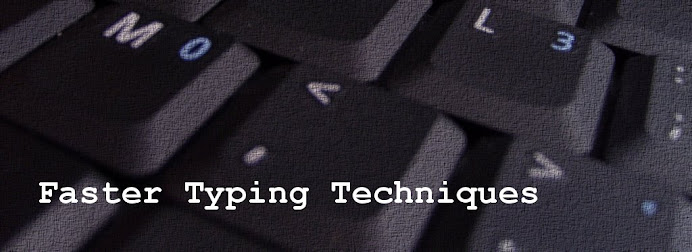The index finger of the left hand is green, and the index finger of the right hand is black. The other fingers are colored the same on both hands. Middle finger is red, ring finger is blue, and the pinky is, well... heh, pink.
 The reason these remaining fingers are the same color on both hands is because I never (as far as I know) cross between the halves of the keyboard with them in ordinary typing. Now, go ahead and follow along in the practice box:
The reason these remaining fingers are the same color on both hands is because I never (as far as I know) cross between the halves of the keyboard with them in ordinary typing. Now, go ahead and follow along in the practice box:Typing is fun.
To type this, press SHIFT with the right pinky. "T" on the left index alternates (after releasing the shift key) to "y" on the right index, "pin" is a "straight" on the right hand, and "g" is back on the left. Now, push the spacebar with your right thumb. The thumbs are color coded white on the chart (which is why you can't see them.) Next, the space combines with the "i" to make another straight. After this, we alternate to "s." To be perfectly honest, I would type that s with either the red or the blue finger.
There are four letters in the sequence which require a left-handed keystroke, and since the other three are all green keys, it doesn't make a difference whether I use red or blue in this case:
Typing is fun.
Here's an example where I use both the blue and the red for s, in two different circumstances:
Rescue your hands.
Right-pinky shift and use the left-index to press R, from the R continue "esc" as a straight. (Since you have to let go of the shift anyway, there's already a slight hesitation between the R and e, which gives you time to move the green finger to the c to complete the "esc" straight.) Alternate to "u" on the right, and back to "e" on the left. Alternate to space and continue into "yo" as a straight. Now strike "u" with the right index, alternate to "r" with the left index, and a straight consisting of space-bar with the right thumb and "h" with the right index. Alternate to "a" with the left blue, and back to the right with "n", to the right with a "ds" straight, and finally the period with the right hand.
You might have wondered why I didn't type your as "your" to make a longer straight. That question has a complicated answer, which I will address in a later topic.
Go ahead and practice both of these sequences in the box provided until they feel comfortable to type with these finger combinations.

No comments:
Post a Comment